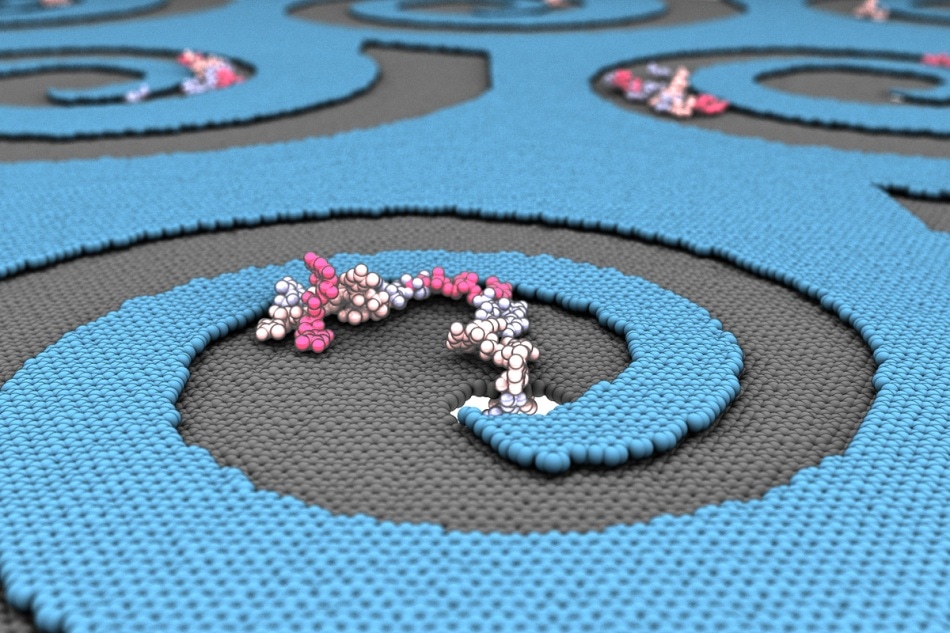Aug 6 2019
Researchers at the University of Illinois speculated how microscopic, step-like defects produced at the time of fabrication could be utilized to enhance molecule transport.
 Laboratory-engineered membrane defects with edges that spiral downward would give biomolecules like DNA, RNA and proteins no other option than to sink into a nanopore for delivery, sorting and analysis. (Image credit: Manish Shankla)
Laboratory-engineered membrane defects with edges that spiral downward would give biomolecules like DNA, RNA and proteins no other option than to sink into a nanopore for delivery, sorting and analysis. (Image credit: Manish Shankla)
The researchers did this while observing the development of porous membranes used for sorting and sequencing of DNA. They discovered that the tiny defects—produced by overlapping membrane layers—make a huge difference in the way molecules move along the surface of a membrane.
The researchers, rather than trying to correct these defects, set out to utilize them to help guide molecules inside the membrane pores. The results of the study have been reported in the journal, Nature Nanotechnology.
In biomedical research, nanopore membranes have created a significant amount of interest since they help scientists to study individual molecules—in an atom by atom fashion—by drawing them through pores for chemical and physical characterization. Such technology can eventually result in the development of devices that can rapidly sequence proteins, RNA, or DNA for personalized medicine.
Earlier in 2014, physics professor Aleksei Aksimentiev and graduate student Manish Shankla from the University of Illinois described a graphene membrane that regulated the movement of a molecule via a nanopore using electrical charge. The duo observed that once the molecules reach the membrane surface, they cannot be easily shuffled into the pores of the membrane, because they prefer to adhere to the surface of the membrane.
While Aksimentiev was on sabbatical at the Delft University of Technology in the Netherlands, he discovered that DNA builds up and adheres along the boundaries of fabrication-formed defects. These defects occur as linear steps, covering across the surface of the membrane.
The objective of the Illinois team was to identify a method where these defects can be used to guide the trapped molecules inside the nanopores. This principle is also applicable to the sorting, delivery¸ and analysis of biomolecules.
To further improve and confirm their observations, the scientists utilized the Blue Waters supercomputer deployed at the National Center for Supercomputing Applications at Illinois as well as the XSEDE supercomputer to model the system and the scenarios of molecular movements at the atomic level.
Molecular dynamics simulations let us watch what is happening while simultaneously measuring how much force is required to get the molecule to clear a step. We were surprised to find that it takes less force to move a molecule down a step than up. Although it may seem intuitive that gravity would make stepping down easier, it is not the case here because gravity is negligible at the nanoscale, and the force required to move up or down should be the same.
Aleksei Aksimentiev, Physics Professor, University of Illinois
Aksimentiev informed that the researchers initially believed that concentric defect patterns that develop around the pores could be used to push down the molecules. However, their simulations revealed how the molecules assemble along the edges of the steps.
That is when it occurred to them that a flaw with edges spiraling into a pore, together with an applied directional force, would give no other option to the molecule, which would then be forced to go into the pore, similar to a drain.
“This way, we can drop molecules anywhere on the membrane covered with these spiral structures and then pull the molecules into a pore,” Aksimentiev said.
According to the researchers, they are yet to create a membrane with spiral flaws in the laboratory; however, that task may be easier than attempting to eliminate a graphene membrane of the present molecule-immobilizing step defects.
When manufactured at scale, defect-guided capture may potentially increase the DNA capture throughput by several orders of magnitude, compared with current technology.
Manish Shankla, Graduate Student, University of Illinois
“After a long development process, we are excited to see this principle used in a variety of other materials and applications such as delivery of individual molecules to reaction chambers for experiments,” stated the scientists.
The study was supported by the National Institutes of Health, National Science Foundation, and the Dutch Research Council.
DNA on graphene steps
In this supercomputer simulation, a DNA molecule, directed by a force, moves down a fabrication-formed step defect along the surface of a graphene membrane. (Video credit: Manish Shankla)